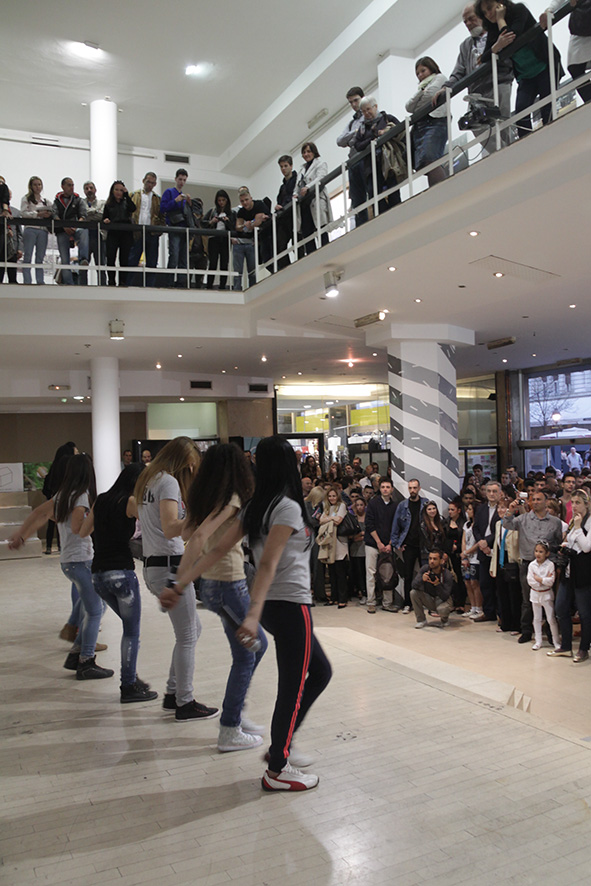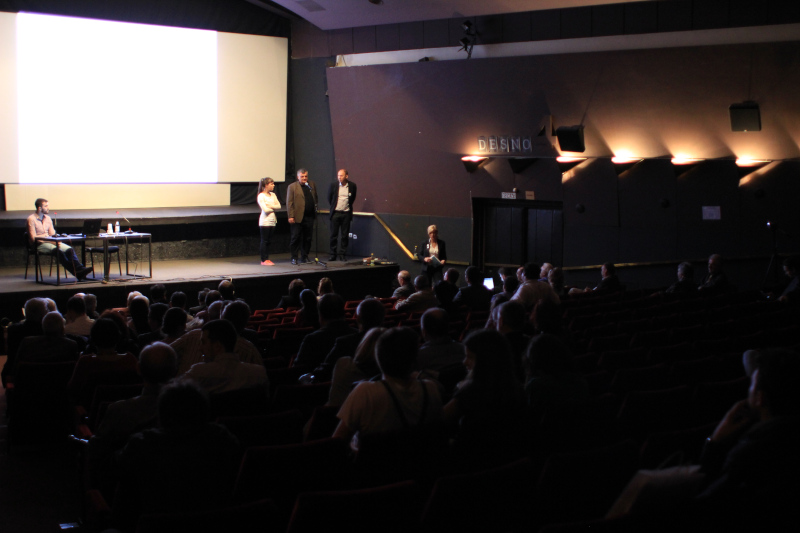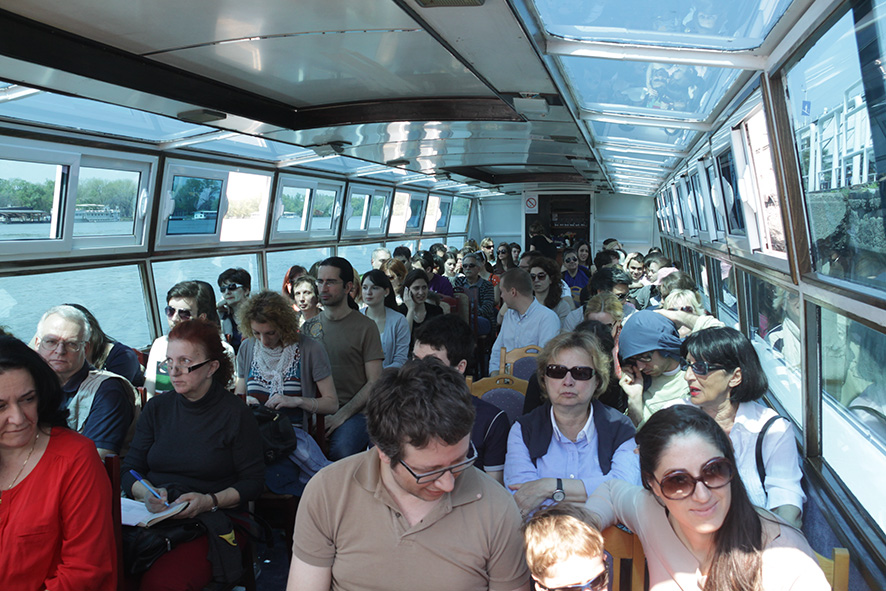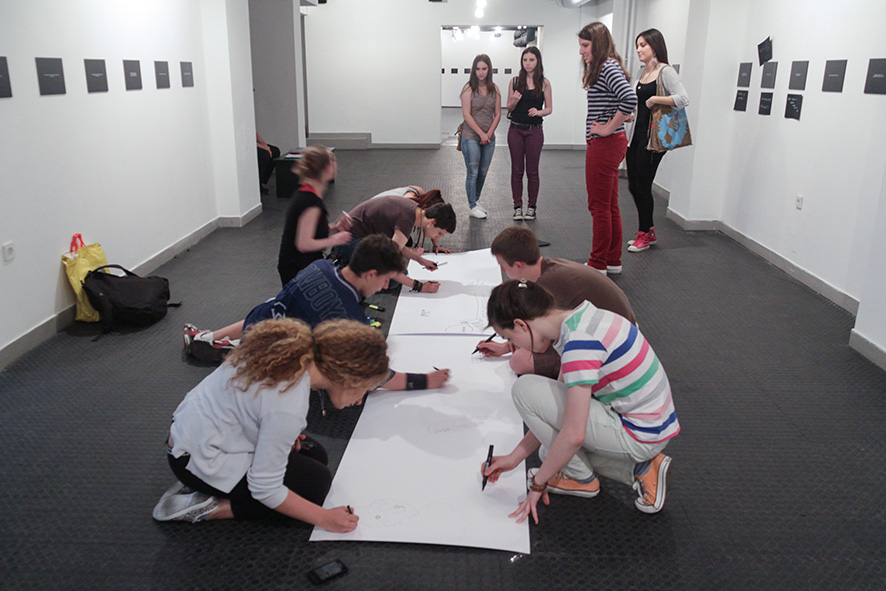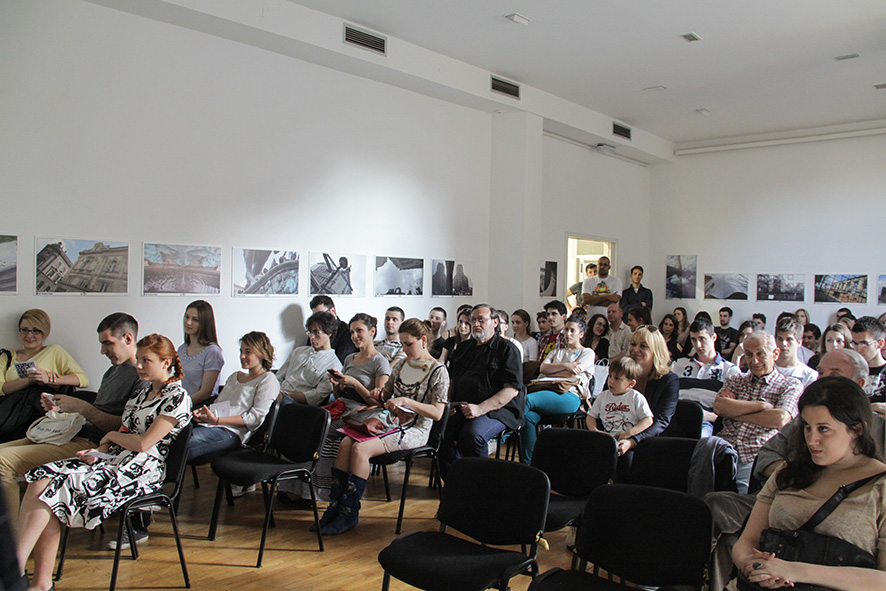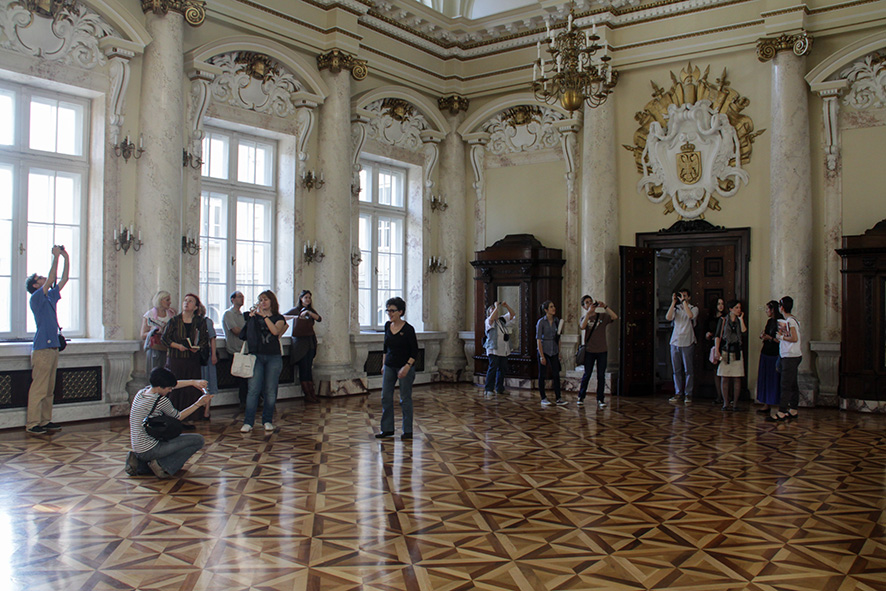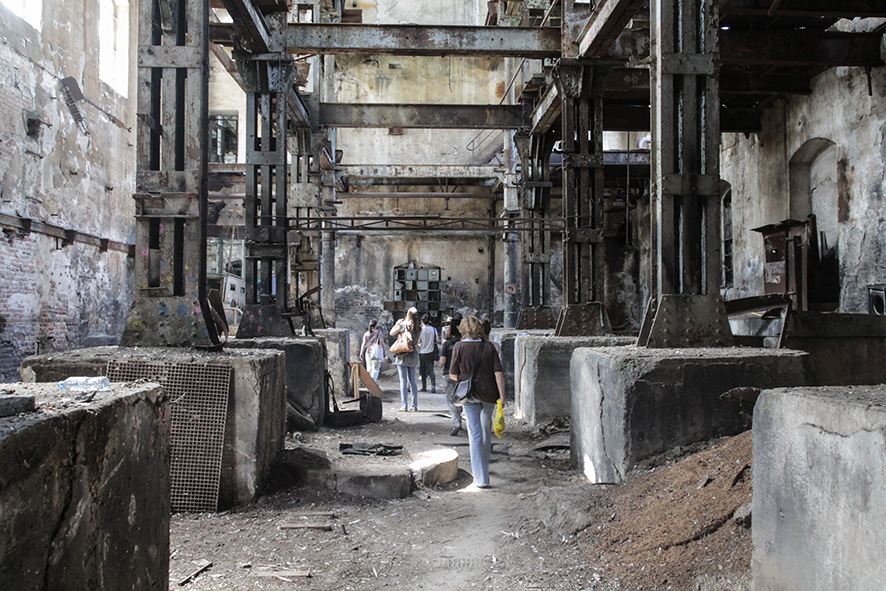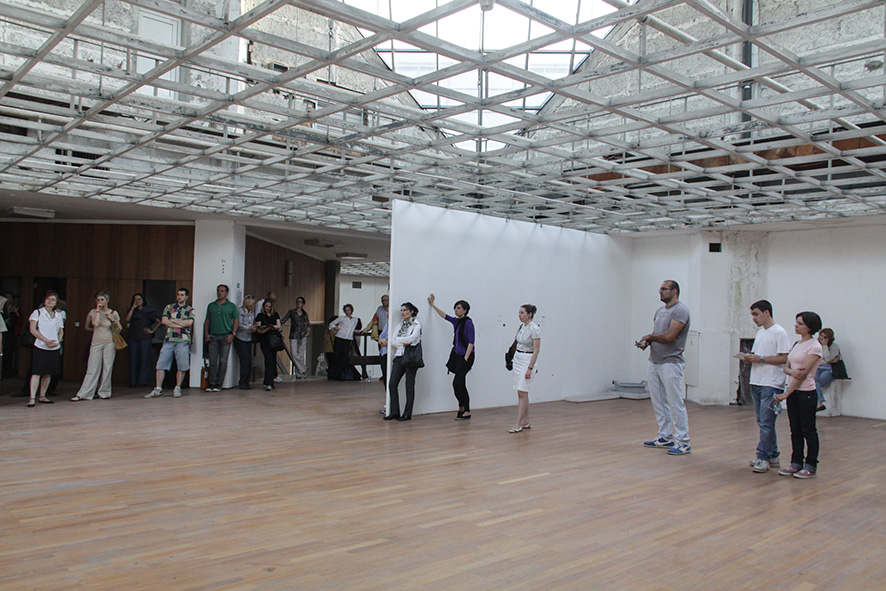2013.
8th Belgrade International Architecture Week
Revealing Architecture
8th – 30th April 2013
“[…] It seems to us that revealing of architecture is all that there is for architects in these diffi cult and challenging times. Therefore we would like to share with you the hope that examination in the process of producing architecture that comes to life in a sparkles of mind and continues until the last bolt is secured at a construction site, will help everyone fi nd their respective places, important not only to architects, but others as well, and to pave the roads that will bring them closer to the environment they intend to change.”
EXHIBITIONS
RE–ARCHITECTURE
Concept: Pavillon de l’Arsenal (France)
Organizer: French Institute in Serbia
The Pavillon de l’Arsenal had invited fifteen European agencies that question the way that modern-day cities are built to participate in this exhibition. Through their original strategies, these architects enact change upon cities which in turn impact on city-life. In Amsterdam, Berlin, Brussels, London, Madrid, Paris or Rotterdam,… these extraordinary teams have taken up a critical stance. They admit to exploring the role of architecture in societal changes. The thirty exhibited proposals, shown at the various stages of development, described the conditions in which the orders were placed, the study behind the projects, participative action as well as the conditions in which studies were carried out and the projects completed.
NEW SLOVENIAN ARCHITECTURE
Author: Damir Kovačić
The exhibition New Slovenian Architecture had represented video-reportage on the most important objects in Slovenia made in the last five years. The aim of the exhibition was to show the overview of the architectural practice in Slovenia through the series of short documentaries. Said practice is considered the most advanced architecture in the countries of former Yugoslavia. In the video reportages, the architects of the most reputable offices, such as Sadar+Vuga, Bevk Perovic, Enota, Groleger arhitekti, Dekleva Gregoric and others, answered the questions regarding the program, constructive and aesthetic characteristics of their objects, but also on the influence investors and economic crisis had on their work.
LE CORBUSIER’S VOYAGE REORIENTED 1911-2011
Curators: Elke Krasny and David Bergé
In 1911 Le Corbusier undertook his formative Voyage d’Orient, which has been considered a reversed Grand Tour. In the course of the 17th century the tour from the North to the South to experience the original sites of classic antiquity had been established as an eminent educational model. Charles Edouard Jeanneret, who called himself Le Corbusier in the 1920ies, chose a very different Grand Tour. His route took him from Berlin via Prague, Vienna, Budapest, Belgrade, Bucharest to Istanbul, Athens, Pompeii, Naples, Rome, Florence and back home to La-Chaux de Fonds in Switzerland. The traveling resulted in a number of documents such as sketches, texts, photographs and collections of postcards.
In 2011 visual artist David Bergé and curator Elke Krasny chose five cities: Athens, Belgrade, Istanbul, Rome and Vienna, which were part of the original tour, as starting points into urban research processes. The Baedeker travel guide and the descriptions of the French orientalists served as orientations for Le Corbusier’s travels. Bergé and Krasny followed only the information provided by local experts in the five cities. The basis of the exhibition were conversations with architects, artists, activists, researchers and intellectuals in Athens, Belgrade, Istanbul, Rome and Vienna. The cities’ distinct qualities, their architecture and their monuments, and the two terms of the Orient and the East triggered the dialogical exchanges.
INVISIBLE CITIES
Authors: PhD students from the Department of Architecture at the Faculty of Technical Sciences in Novi Sad
Mentor and exhibition display: Jelena Todorović
The exhibition Invisible Cities represented works of the PhD students of architecture at the Faculty of Technical Sciences in Novi Sad and is the result of the artistic-literary project done under supervision of the professor Jelena Todorović. Inspired by the work Invisible Cities of the famous Italian writer Italo Calvino, this exhibition of models of the cities represented spatial and creative exploration of conceiving the boundary space in literature. During the summer semester of 2012, students went to the course dedicated to examining the boundary spatial phenomena in art history and culture. There they had a task to explore spaces of Calvino’s cities. For Calvino, city is saliently a set of feelings, wishes, memories, experiences, and the past both real and yearned. The main task of this project was to take Calvino’s work as the starting point of a deeper, both spatial and personal re-examination, and to turn imaginary cities of the literature into three-dimensional personal experiences of the students themselves. Each student made a model of the city which is a deeply lived spatial and emotional response to Calvino’s work.
Authors: Renata Balzam, Tatjana Čegar, Bojana Dragutinović, Dejan Ecet, Norbert Harmati, Lana Isakov, Ivana Marcijuš, Karl Mičkei, Slavenka Mitrović Lazarević, Dejan Pavlović, Aleksandra Pešterac, Andrea Tamaš, Višnja Žugić
EYE OF THE CITY
Authors: Dragan Kujundžić and Željko Šafar, Association of photography authors (APA)
Projects Aye of the City aimed to mobilize youth from marginalized groups and give them the opportunity to express the experience od their life in Belgrade through artistic photos. To these young people gathered in the singing-dancing workshop GRUBB, mostly from the Roma population, photographers Dragan Kujundžić and Željko Šafar from Association of photography authors (APA) had provided training, equipment and support during the shooting. Top 40 photos were exposed on Belgrade International Architecture Week, they were on sale, and the funds were earmarked for their education.
UIA REGION 2 – BALKAN ARCHITECTURE CONFERENCE
Organization: Union of Architects of Serbia and Faculty of Architecture of Belgrade University
Program Director: Ivan Kucina
Exhibition that was following UIA Region 2 meeting and Balkan Architecture Conference wanted to identify architecture strengths and potentials despite the political and economical austerities. Works selected by the local representatives provided insights into the complex realities of architectural production within the UIA Region 2 and elaborate concepts of the architecture relevance that were meant to support and inspire architects in their engagement.
MODERNISM IN SERBIA
Authors: First year students of academic studies MA 2010/11, from the Faculty of Architecture at the Belgrade University
Teacher: Ljiljana Blagojević
Teaching Associate: Dragana Ćorović
Organizer: Do.co.mo.mo Serbia
At the Faculty of Architecture of Belgrade University, at graduate academic MA studies (first year, first semester of school year 2010/2011), there was initiated an elective course Contemporary Architecture: Modernism in Serbia, in accordance with the syllabus of dr Ljiljana Blagojević, associate professor. The main goal of the course was for students to gain an insight into the modern architecture of the twentieth century in Serbia, in the wider cultural and socio-historical context of Yugoslavia (1918-1991). In the same year, in 2010, Do.co.mo.mo Serbia was founded, whose first president was Dr. Ljiljana Blagojević. During the semester, students collected and classified project documentation, professional texts and other relevant data about many significant achievements and authors of modern architecture in Serbia, so that, after several months of work, the result of each student was the formation of a complete file of one of those works. The results of the work on the subject were shown to the wider professional public by the presentation of documentation material and a forum at the 33rd Salon of Architecture in Belgrade.
FIFTY OBJECTS OF MODERN MOVEMENT OF NIŠ,
1930 TO 1970
Author: Aleksandar Keković
Production: Association of Nis Architects
With the occasion of two great jubilees of Association of Niš Architects in 2011, 120 years of organized engineering in Niš and 50 years since the foundation of Association of Niš Architects, a series of four exhibitions were started. They were intended to represent the architecture of Niš since 1878, when the city was liberated from the Ottomans, up until today’s – contemporary architecture of Niš. The second in the series was the exhibition Fifty Objects of the Modern Movement of Nis 1930–1970 – fifty of the most representative public and residential objects of early and late modern movement, which were created in this intensive development period from 1930 to 1970 were shown over fifty panels.
100 CLASSICS: CHAIRS THAT HAVE THEIR PLACE
IN HISTORY
Exhibition of chairs miniatures – Vitra design museum
Organizer: NITEA
One of the most important and the most interesting collections of Vitra design museum is the collection of chair miniatures. The collection of the miniatures contain 100 classics – 100 chairs that have marked the production of the furniture in the last two centuries in the two centuries, from 1850 to 1990. At the exhibition one could follow the history of architecture, technology and society through the development of the chair production. The miniatures offer extraordinary insight into every detail of the design. The exhibition presented chairs, not just like an isolated phenomenon, but also explained the place and the role of this object in a cultural and historical context. The reproductions of drawings and photos of the authors followed the exhibition. The setup was designed in such a way to provide information on the social, economic and cultural circumstances which were influential for the work of the authors and the performance of the product.
WALKS
Thematic walks through the architecture of the city intended for the widest audience are organized every year in cooperation with various organizations, individuals and institutions. This year’s BINA included eight walks in its program: Banks of the Sava River and What Connects Them, Secession in Belgrade, I am a Belgradian, New look at New Belgrade, Architecture and the Army, Belgrade Industrial Heritage, Belgrade Secrets, Belgrade Vantage Points.
LECTURES / WORKSHOPS
During the eighth BINA festival, a large number of workshops were organized for children, young people and students, on various topics: Scenography of the City, Earth Architecture, Animated Architecture: Little School of Animated Movie, Six Urban Hats, Be an Architect. Learn and try, Five kilometres in two minutes, etc.
A series of lectures by domestic and international professionals was organized, which concerned the disclosure of the city, architecture, architectural heritage and devastated buildings awaiting the final decision on restoration or demolition, as well as the promotion of several books, the summer school of architecture in Petnica, an internet platform and held Balkan Conference of Architects.
BETWEEN TWO BINAs
Annual Awards for Architecture in the period May 2012 – April 2013
Architecture and urban planning competitions in the period May 2012 – April 2013
Organizers: Association of Belgrade Architects (ABA) and the Union of Architects of Serbia (UAS)
